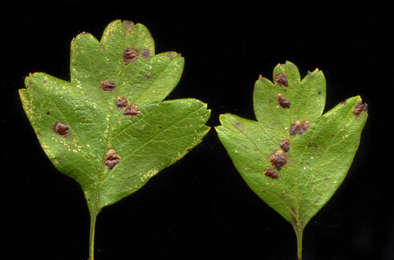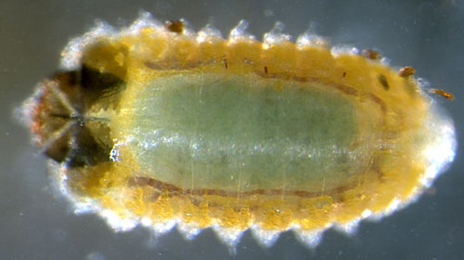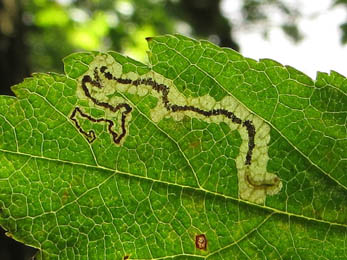|
||||||
|
AMELANCHIER. Juneberries and Snowy Mespilus. [Rosaceae] |
|
Only one species of Amelanchier, the native Juneberry (A. lamarckii), is recorded in Britain. The BSBI provide a downloadable plant crib for Amelanchier. Sixteen British miners are recorded on Amelanchier. A key to the European miners recorded on Amelanchier is provided in Bladmineerders van Europa. |
|
Key for the identification of the known mines of British |
1a > Leaf miner and case-bearer: The larva lives outside the mine, protected by a case, and feeds on the underlying plant tissues via a hole cut in the epidermis. Mine does not contain frass |
1b > Leaf-miner, but not a case-bearer: The larva lives inside the mine. Mine usually contains frass |
2a > Leaf-miner and case-bearer: The species spends two years as a larva, the first one-and-a-half years in a small pistol-case, and in the second spring building a long straight case which is dark brown and rather distinctive. The lava lives from autumn until summer next year. In autumn a composite leaf case is made, shaped like the handle of a walking stick. Early in the following spring a tubular leaf case is made that in the end is rather large (10 mm) and is positioned vertically on the leaf; mouth angle 90°. |
|
Coleophora hemerobiella (Scopoli, 1763) [Lepidoptera: Coleophoridae]. |
2b > Leaf-miner and case-bearer: The larva feeds by inserting its head into small mines it creates on the leaves of birch, elm, alder, or hazel. Occasionally it is found feeding on other trees, or on herbaceous plants onto which it has accidentally Fallén. It forms two cases during its larval life. The first case is initially curved, smooth, laterally compressed with a bivalved anal opening, and about 2 mm long in September. During October it feeds, and adds a few rough collars of larval material around the oral opening. After hibernation, it feeds again in April and early May, adding more protruding collars until they equal or exceed the original smooth part of the case. At the same time, it expands the case girth by the creation of a silk gusset ventrally. The second case, 6 or 7 mm long, is formed in May, leaving the vacated first case attached to its last feeding mine. The new case is tubular with a trivalved crimp at the anal opening. The dorsum is formed from the edge of the leaf from which the case was cut. This results in a more or less serrated dorsal keel, depending on the plant species and the individual piece of leaf used. Considerable variation in the degree of serration can be found, even among specimens off the same tree. The case colour varies with food plant, from yellowish brown on birch, darkening through elm and hazel to dark brown on alder. The strongly curved young case is is a composite leaf case, the adult case is a tubular leaf case. The adult case is bivalved, about 7 mm in length; the mouth angle is around 30°. The case is straw coloured and almost always has a toothed dorsal keel (remnant of the margin of the leaf from which the case was cut). Neither larvae or cases of C. coracipennella, prunifoliae, serratella and spinella can be separated; from serratella. |
|
Coleophora serratella (Linnaeus, 1761) [Lepidoptera: Coleophoridae]. |
3a > Leaf-miner: The larvae initially mining the leaves in a short, contorted gallery. As the larva develops it leaves the mine to feed externally, creating windows on the upperside of the leaves. Oviposition at the leaf upperside, egg shell iridescent. Small, hook-like corridor, mostly in a vein axil. Frass in a very thick central line. The larva soon leaves the mine through an untidy hole and subsequenty feeds living freely on the leaf. Pupation occurs in a ribbed white cocoon spun on debris. The winter is passed in this stage.. |
|
Bucculatrix bechsteinella (Bechstein and Scharfenberg, 1805) [Lepidoptera: Bucculatricidae]. |
3b > Leaf-miner: A circular or oval brownish blotch with a central spiral of dense blackish frass (British leafminers), sometimes several mines in one leaf. Oviposition is at the leaf underside, well away from the leaf margin; the egg has a fine reticulate surface. The mine is a rather large, perfectly circular blotch without a trace of a preceeding corridor. Around the dark centre the frass, glued to the upper epidermis is arranged in distinct arcs. Pupation in a silken cocoon, usually on detritus. |
|
Leucoptera malifoliella (O. Costa, 1836) [Lepidoptera: Lyonetiidae]. |
3c > Leaf-miner: A long, whitish smoothly-curved upper-surface mine with broken black frass. Oviposition is by means of an ovipositor; what remains is a small scar: no egg shell is visible at the start of the mine. From here a long, sometimes very long, slender, full depth corridor winds throught the leaf, not steered by leaf margin or the leaf venation. The midrib is crossed effortless; the corridor frequently also crosses itself; the section of the leaf cut off then usally turns brown and dies off. Frass in a narrow central line. The larva vacates the mine prior to pupation through an exit in the upper epidermis. The vacated larval chamber is proportionally much longer than in the case of Stigmella mines ( > 3 x longer than broad). Pupation in a silken cocoon suspended from threads attached to food plant or other vegetation. |
|
Lyonetia clerkella (Linnaeus, 1758) [Lepidoptera: Lyonetiidae]. |
3d > Leaf-miner: In a small Phyllonorycter-like mine initially, but with brown rather than green lower epidermis. Later in two or more successive cones formed by folding leaf-lobes downwards. The mine begins at a flat, iridescent egg shell. It starts as an epidermal corridor, widening into (and mostly over run by) a shallow lower surface blotch in the tip of a leaf segment. The lower epidermis is off-grey with small light brown spots at first, but soon turns brown. Silk is deposited within the mine, causing it to contract. This wrinkles the lower epidermis, but there are no clear folds formed. Soon the larva starts consuming the palissade parenchyma, and the upperside of the mine than turns brown as well. Frass in loose grains. After some time the larva leaves its mine and continues living free under a downfolded leaf segment, kept in place by some spinning. Here too the leaf tissue is consumed up to the palissade parenchyma, browning the leaf. |
|
Parornix anglicella (Stainton, 1850) [Lepidoptera: Gracillariidae]. |
3e > Leaf-miner: The mine is in the upper epidermis of a leaf, usually over midrib or vein. The mine is at first silvery, later with brown speckling. Silvery, upper-surface, epidermal tentiform mine, centered over the midrib or a heavy lateral vein. Unlike P. leucographella, with which this species shares some host plants, the upper epidermis looks dirty by the presence of numerous fine black-brown specks of frass. The epidermis remains without folds until the mine becomes strongly contrated. Young mines look like a streak of silver on top of a vein. |
|
Phyllonorycter corylifoliella (Hübner, 1796) [Lepidoptera: Gracillariidae]. |
3f > Leaf-miner: Lower-surface, yellow-green tentiform mine, 20-32 mm long, with a number of fine folds in the lower epidermis. In most cases the mine is elongate, situated between two lateral veins. The reddish to chestnut brown pupa lies in a flimsy cocoon in which no frass is incorporated: the frass is stored not in a clump but in a row of loose grains behind the cocoon. Just before edcysis the pupa works itself out of the mine through the lower wall; mostly the empty exuvium sticks halfway out of the mine. |
 Mine of Phyllonorycter mespilella on Sorbus Image: © Martin Gray British leafminers) |
|
Phyllonorycter mespilella (Hübner, 1805) [Lepidoptera: Gracillariidae]. |
3g > Leaf-miner: The young larva mines the leaves of its foodplant then hibernates. It will then mines leaves or flowerbuds, then blossom or leaves. Branched, sometimes stellate, brownish, very transparent, sometimes long corridor that contains no frass. All frass is ejected through a number of tiny openings that generally are close to a vein. Only the young larvae are miners. |
|
Recurvaria nanella (Denis & Schiffermüller, 1775) [Lepidoptera: Gelechiidae]. |
3h > Leaf-miner: Usually a very small (but see below), pear-shaped, upper-surface blotch, most of it stuffed with reddish brown frass. Often several mines in a leaf. Ovipisition is already in May, but the larvae hatch late and initially develop very slowly; only against the end of summer the mines become apparent. Thelarvae remain in the mine and hibernate in the fallen leaves. The bright-coloured frass and their large number makes these mines very conspicuous in autumn, despite their small size. The weevils feed pinhole-sized windows in the leaf upperside (maturation feeding). |
 Minee of Rhamphus oxyacanthae on Crataegus monogyna Image: © Willem Ellis (Bladmineerders van Europaa) |
 Rhamphus oxyacanthae larva, dorsal Image: © Willem Ellis (Bladmineerders van Europa) |
|
Rhamphus oxycanthae (Marsham, 1802) [Coleoptera: Curculionidae]. |
3i > Leaf-miner: The frass linear in early gallery, widening to blotch with dispersed frass. Oviposition at random point of the leaf, either at upper- or lower-surface. First a quite slender corridor is made, with a relatively broad, continuous, frass line, that always leaves a clear margin at either side; the corridor winds freely through the leaf. This initial corridor often abruptly changes in direction, widens into a blotch that mostly lie along the leaf margin. Pupation outside the mine. |
|
Stigmella hybnerella (Hübner, 1813) [Lepidoptera: Nepticulidae]. |
3j > Leaf-miner: A long thin linear gallery with frass in a thin line, sometimes broken. This distinguishes it form S.nylandriella, which never has linear frass throughout the mine. The gallery of S.magadalenae is also narrower than S.nylandriella. S. magdalenae can both be an edge miner or make a small mine in the leaf blade, or run along a vein. Egg at the underside of the leaf, independent of the venation. The corridor is narrow from start to end, and compressed on a small space, sometimes following the leaf margin for a while, more often along a major vein. Frass in a narrow, regularly interrupted central line. In thick leaves the frass line is broader, and the corridor is shorter. |
|
Stigmella magdalenae (Klimesch, 1950) [Lepidoptera: Nepticulidae]. |
3k > Leaf-miner: Rather short, full depth, gradually widening corridor, the last section suddenly widenened still a bit more into an elongated blotch. Frass in a central line, about 1/3 of the width of the corridor. Pupation outside the mine. |
|
|
Stigmella mespilicola (Frey, 1856) [Lepidoptera: Nepticulidae]. |
3l > Leaf-miner: The reddish frass is linear, later in arcs, finally dispersed. Long corridor, that widens only little, and winds freely through the leaf, not influenced by the venation. In thick, sun-exposed leaves the mine may be much shorter, especially in Cotoneaster, Malus and Pyrus. Frass brown, in arcs.. |
|
Stigmella oxyacanthella (Stainton, 1854) [Lepidoptera: Nepticulidae]. |
3m > Leaf-miner: A narrow gallery leads abruptly to large blotch. Oviposition on the leaf underside. The mine begins as a very slender winding corridor of 15-20 mm, the second part of which is almost stuffed with frass. The corridor abruptly widens into a blotch with dispersed frass; in large leaves this blotch is almost circular. Mostly the midrib is not crossed, but the mine can occupy the major part of a leaflet. Often several mines in leaf. |
|
Stigmella sorbi (Stainton, 1861) [Lepidoptera: Nepticulidae]. |
3n > Leaf miner. The egg is deposited in the base of the midrib. After oviposition the female severes the petiole, causing the petiole to break. The leaf start to wilt and falls, but still remains green for a considerable time. The larva tunnels in the midrib, and makes from there broad, full deep blotches in the lamina. Frass dispersed in the mine. Often several larvae in a leaf. Pupation in the ground. Blommers & Vaal (2002a) and Gønget (2003a) describe the biology in more detail.. |
|
Neocoenorrhinus pauxillus (Germar, 1824) [Coleoptera: Rhynchitidae]. |
| Last updated 30-Jun-2019 Brian Pitkin | ||

